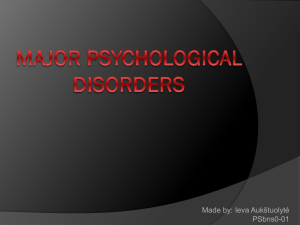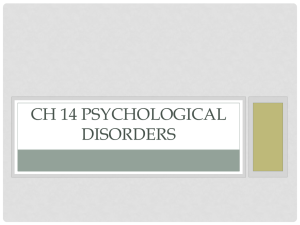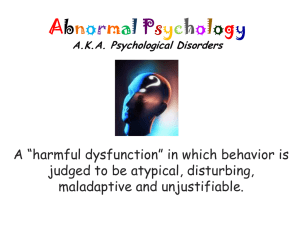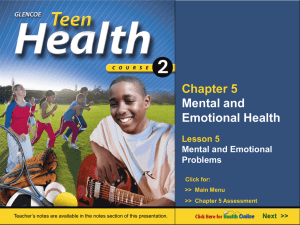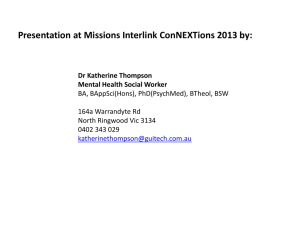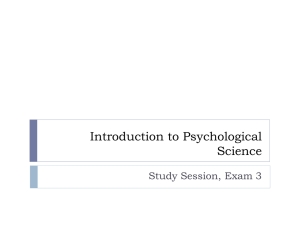Psychological Disorders
advertisement
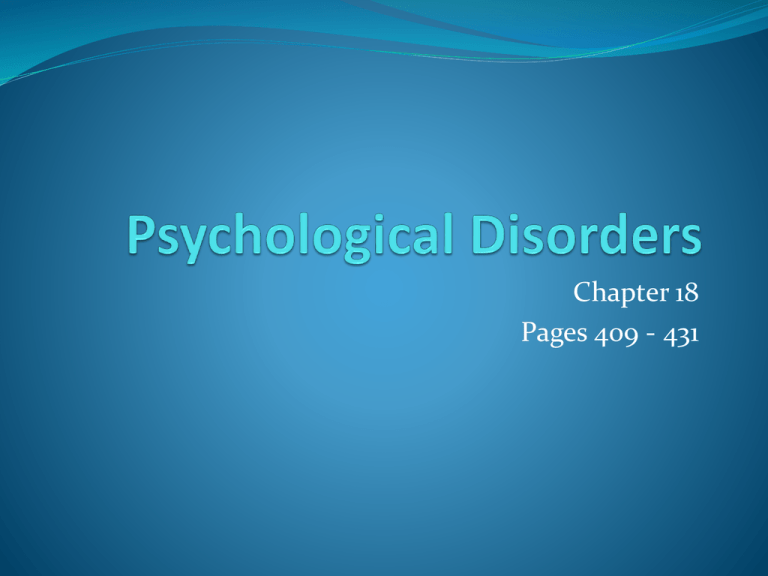
Chapter 18 Pages 409 - 431 Criteria used to determine Psychological Disorder Behaviors, patterns or mental processes that cause serious personal problems or suffering Exaggeration of certain behaviors or mental Psychological Disorders Typicality Degree to which is average or typical or behavior or mental process Example: if somebody rearranges their locker after every single period, is that abnormal….? Maladaptivity Behavior impairs an individual’s ability to function adequately in everyday life Examples: Alcohol abuse Suicide Abusive to others Emotional Discomfort Suffering helplessness, hopelessness, and worthlessness, often suffering from depression or anxiety Often loose interest in activity they used to enjoy Socially Unacceptable Behavior Behavior that violates a society’s accepted norms Culture-bound syndrome- cluster of symptoms that define or describe an illness, often the behavior is seen differently by different cultures Example: banging one’s head in Middle East culture person is seen as being possessed by an evil spirit or jinn, in the United States seen as a psychological disorder What are exceptions? Or norms that have changed over time? Example: during the years of slavery a runaway slave was seen as someone who was mad or crazy, of course now it seems completely understandable. Typicality Maladaptive Emotional Discomfort Socially Unaccept.. Behavior Find a partner: interview one of the following professionals 1. Police officer 2. Attorney 3. Judge 4. Psychologists Ask question: Does the insanity plea allow people to “get away” with crimes? Diagnostic and Statistical Manual of Mental Disorders…. DSM American Psychiatric Association Used as the guidelines to determine if somebody has a mental illness The following slides are all the disorders that are listed in the DSM Anxiety disorder DSM lists the following as Anxiety disorders Phobic disorder Panic disorder Generalized anxiety disorder Obsessive-compulsive disorder Stress disorders Phobias Intense irrational fear of something What are your phobias? Social Phobia: intense fear of social situation and having people make fun of you or feeling humiliated Do you know anyone with this phobia? Panic Disorder and Agoraphobia Panic attack- characteristic of these disorders, shortness of breath, dizziness, rapid heart rate, trembling or shaking, sweating, choking etc. can last a few minutes to several hours. Agoraphobia- fear of being in places in which escape would be impossible for difficult What might be some examples? 50-80% of people with phobic disorder are one of the above Both of these disorders can lead to avoidance behaviors How could this be disruptive for daily life? Role Play! With a partner take about 5 minutes to create a scenario demonstrating a simple phobia, social phobia, panic disorder, or agoraphobia. Include in your skit avoidance behavior to mask or manage the fear Be ready to discuss ways in which anxiety disorders affect people’s work and social life. Generalized Anxiety Disorder Excessive or unrealistic worry about life circumstance that lasts for more then 6 months Most common anxiety disorder Often people with GAD have other anxiety disorders too Obsessive-Compulsive Disorder OCD Obsessions- unwanted thoughts or ideas that occur over and over again (fear of somebody breaking into the house) Compulsive- repetitive ritual behaviors, often involving checking and/or cleaning something over and over again (rechecking the locks on windows and doors of the house a dozen times or more before can relax) Post-traumatic Stress Disorder PTSD Occurs have severe trauma: war, rape, child abuse, natural disaster etc. Not everyone who experiences a trauma will develop this Flashbacks Nightmares Numbness of feeling Avoidance of situations related to trauma Difficulty sleeping, relaxing Symptoms can start up to 6 months after trauma and last for years Acute Stress disorder- similar to PTSD, but coming on sooner and not lasting as long Psychological Views on Anxiety Disorders Based on learning theorists ideas- if child picks up spiders and adult freaks out then child learns to be phobic (think classical and operant conditioning) Biological views Born with disorders Example: if one identical twin shows disorder the other has a 45% of developing the same Passed down through the gene pool, ancestors more likely to survive and reproduce if they had fears of real dangers, such as heights, snakes etc. Journal What avoidance behaviors have you used to reduce anxiety about a particular situation or object, explain how facing the situation rather then avoiding might help you overcome it? Dissociative Disorder Do you sometimes space our during class? Do you sometimes miss a turn off because you were thinking of something else? Do you get so involved in a book or show that you don’t hear your name? If you answered “yes” to any or all of the questions you have dissociated. Don’t worry you are not crazy! Dissociative Disorder People will remove themselves mentally from a stressful/ traumatic situation to lesson the anxiety Sometimes people will lose their memory or identity Dissociative Amnesia Forget the events surrounding a stressful/traumatic event Can last a few days to years Not associated with head injury Common during war time or natural disasters Dissociative Fugue Not only forgetting personal information and events, but relocating and taking on a new identity When fugue ends the no longer remember being in the fugue state Dissociative Identity Disorder Multiple personality disorder (movie Sybil retells one of the most extreme and famous cases of this) Two or more personalities with in the same person Each personality has different voice, personality, facial expression Personalities control the individual when they are in that state Common in children who have experienced severe abuse Depersonalization Disorder Feelings of being outside body watching events going on around you Again most often happens after traumatic or stressful event Explaining dissociative disorders psychoanalytic theory (Freud, Young) Believed person is trying to resist undesirable urges or events from the past Learning Theory- people have learned to not think about disturbing events as a way to avoid feelings of guilt, shame, or pain No clear explanation as to the source for dissociative disorders True/False Quiz Fold sheet of paper in half (long ways) Write 10 true/false questions on dissociative disorders on the left hand side of sheet Write the answer to each question on the same line on the right hand of sheet Switch with class mate and have them take your quiz Mood Disorders Extreme emotions that are not connected to “real” event or situatation Depression- feelings of helplessness, hopelessness, worthlessness, guilt, sadness Bipolar disorder- cycle of moods from depression to manic (elated, hyper-active etc.) Depression very common- every six months 8% of women and 4% of men will be diagnosed with depression…8 – 18% of population will experience major depression in lifetime Somatoform Disorders Psychological distress through physical symptoms Depression with 5 out of 9 Persistent depressed mood for most of day Loss of interest or pleasure in all activities Significant weight loss or gain due to changes Sleeping more or less than usual Speeding up or slowing down of physical and emotional reactions Fatigue or loss of energy Feelings of worthlessness or unfounded guilt Reduced ability to concentrate or make meaningful decisions Recurrent thoughts of death or suicide Bipolar Manic phase can be characterized by following: Inflated self-esteem Inability to sit still or sleep restfully Pressure to keep talking and switching from topic to topic Racing thoughts (referred to as “flight of ideas”) Difficulty concentrating Theories on Mood Disorders Psychoanalytic (Freud)- loss of real or imagined loved one as child, internalized feelings then directs as oneself Learning Theorists- people learn helplessness makes them prone to depression Cognitive Theorists- habitual style of explaining life events… Internal- may fault Stable- problem can not be changed Global- problem too big to solve Biological explanation Mood Disorders 20 – 25% of people with mood disorder has a family member that also has it 2 neurotransmitters: serotonin and noradrenalin if deficient in either mood disorder, if both often depression Schizophrenia Characterized with a loss of contact with reality symptoms Hallucinations Delusions Thought disorders Catatonic stupor *estimated that 2 million people in us have schizophrenia Paranoid schizophrenia Delusions/hallucinations- related to single theme Disorganized schizophrenia Disorganized speech and thought can also have hallucinations, but are more random and disorganized then paranoid schizophrenia Catatonic Schizophrenia Disturbance of movement, may hold very uncomfortable position for hours even after hands and legs swell Activity can slow to stupor or become very agitated Psychoanalytic Explanation Overwhelming of ego by urges from id/ causing intense conflict Psychological Views Family environment can push/ “cause” schizophrenia, such as a pushy, or critical parent Biological Views Schizophrenic people have smaller frontal lobes then normal brain, affects: Attention Memory Abstract thinking Language Suggested that difficulty forming pathways and synopses in that part of brain Biological continued Causes Heredity- 10% increased chance if one parent has/35 – 40% if both Complications during pregnancy- influenza (increased risk if born in winter/flu season), maternal starvation Look at the Multifactorial model of Schizophrenia on page 429 (copy it for your exam) Personality Disorders Patterns of inflexible traits that disrupt social life/ work etc Enduring traits that become “part” of person’s personality vs. psychological disorders which exhibit episodes of illness, but can be distinguished from person’s personality Personality disorders/characteristics Paranoid- suspicious, distrust others’ motives Schizoid- detachment from social behavior Schizotypal- acute discomfort in close relationships Antisocial- no concern for others Borderline- instability in interpersonal relationships and selfimage Histrionic- excessive emotionality, need for attention Narcissistic- Grandiosity, need for admiration, lack of empathy Avoidant- social inhibition, feelings of inadequacy Dependent- submissive, clinging Obsessive-Compulsive- obsession with orderliness, perfectionism, and control Theories Psychoanalytic- lack of development of superego (children rejected never develop sense of guilt) Learning Theorists- children learn from violent role models, or anti-social role models Cognitive Theorists- see other people’s behavior as threatening, use it to justify anti-social behaviors Biological- higher in individuals with parents who have it/ differences in frontal part of lobe of the brain which handles emotions

